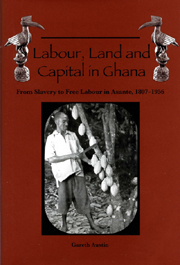Book contents
- Frontmatter
- Contents
- List of Illustrations
- List of Tables
- Preface
- Note on Names
- Maps
- Note on the Maps
- 1 Introduction
- Part I Context and Concepts
- Part II Social Relations of Production and Trade, 1807–1896: Absent and Imperfect Factor Markets
- Part III Slavery as Hobson's Choice: An Analysis of the Interaction of Markets and Coercion in Asante's Era of ‘Legitimate Commerce’, 1807–1896
- Part IV The Decline of Coercion in the Factor Markets of Colonial Asante: Cocoa and the Ending of Slavery, Pawnship and Corvée, 1896–c.1950
- Part V Social Relations of Production and Trade, 1908–1956: Towards Integrated Factor Markets?
- Part VI Freedom and Forest Rent, 1908–1956
- Abbreviations Used in the Notes
- Notes
- List of References
- Index
Part II - Social Relations of Production and Trade, 1807–1896: Absent and Imperfect Factor Markets
Published online by Cambridge University Press: 12 September 2012
- Frontmatter
- Contents
- List of Illustrations
- List of Tables
- Preface
- Note on Names
- Maps
- Note on the Maps
- 1 Introduction
- Part I Context and Concepts
- Part II Social Relations of Production and Trade, 1807–1896: Absent and Imperfect Factor Markets
- Part III Slavery as Hobson's Choice: An Analysis of the Interaction of Markets and Coercion in Asante's Era of ‘Legitimate Commerce’, 1807–1896
- Part IV The Decline of Coercion in the Factor Markets of Colonial Asante: Cocoa and the Ending of Slavery, Pawnship and Corvée, 1896–c.1950
- Part V Social Relations of Production and Trade, 1908–1956: Towards Integrated Factor Markets?
- Part VI Freedom and Forest Rent, 1908–1956
- Abbreviations Used in the Notes
- Notes
- List of References
- Index
Summary
The ultimate purpose of this part is to offer a systematic description of the institutions within which users of labour, land and capital obtained these resources, from the beginning of the end of the Atlantic slave trade to the imposition of colonial rule. But in a contentious and, in certain respects, under-researched subject a description can be established only through analysis. The discussion will focus on the extent to which, and the forms in which, markets operated. In the process we will reconsider critically the significance of certain concepts in the literature on the nineteenth century, such as sharecropping and cooperative work groups. More generally, we need to assess how far the ending of the Atlantic slave trade and the growth of the kola and rubber trades strengthened the commercial element in the social relations of production and trade. I will begin with the rules of ownership and control, formal and informal, over the most abundant factor, land, and proceed to discuss those that applied to the scarce resources of labour, capital and credit.
We will see that the Asante state enforced private property rights, notably those of slave-owners and creditors. Property rights create incentive structures, but they also distribute power, giving rights over resources to some and denying them to others. Underpinning the extensive extra-subsistence activity of the Asante economy, as we have seen already, was the state's military and political actions, which secured for Asantes the lion's share of the more valuable natural resources of the neighbourhood.
- Type
- Chapter
- Information
- Labour, Land and Capital in GhanaFrom Slavery to Free Labour in Asante, 1807–1956, pp. 97 - 98Publisher: Boydell & BrewerPrint publication year: 2005



